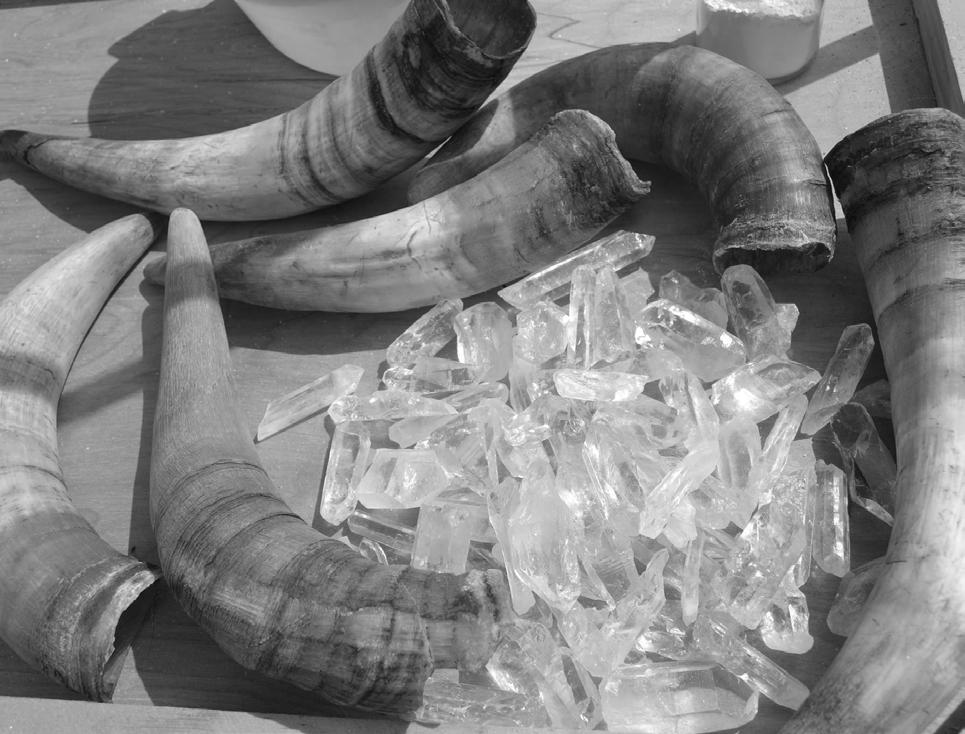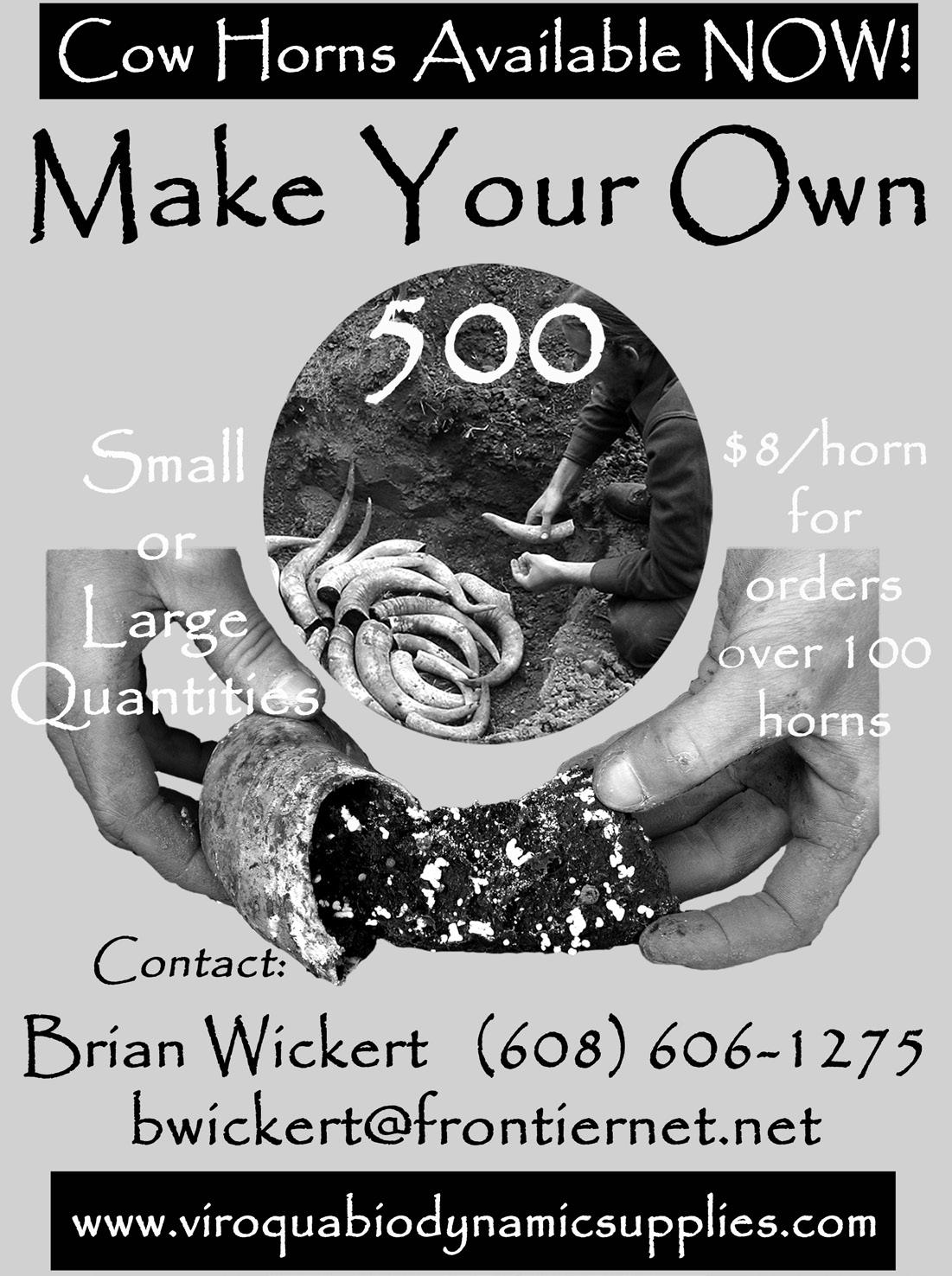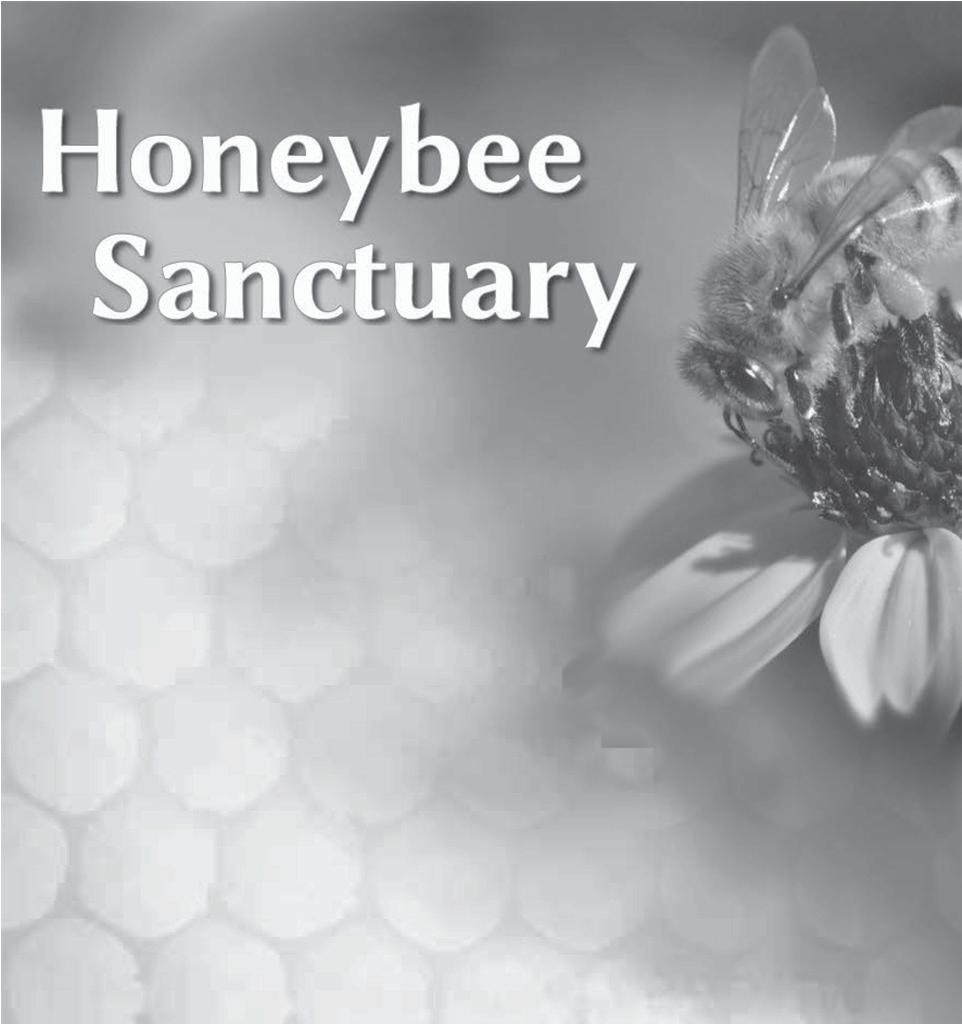
8 minute read
THOUGHTS ON THE BIODYNAMIC PREPARATIONS
DENNIS KLOCEK
Even among the most ardent supporters of biodynamic agriculture, the issues involving the biodynamic preparations have a distinct air of complexity. To a business owner, explaining to a corporate client or a customer why cow manure is put into a cow horn as an amendment is a demanding task. To practitioners, the effects of the preparations are so subtle that they may seem to be an exercise in belief rather than a practical production tool. This doubt can turn the stirring of the silica and horn manure into a ritual of impatience in the context of a busy schedule. For these reasons and most likely several more there apparently is sentiment in biodynamic circles to marginalize or even eliminate the
BD preparations from biodynamic practices. Perhaps this is understandable from these perspectives but it reveals a lack of insight into the alchemical principles that Rudolf Steiner introduced in the methods used to make the preparations. The alchemical method of analogy used in the thinking around the preparations is not common knowledge. However, current research in plant and animal physiology is revealing that these more intuitive methods may be important for future developments in agricultural research. As an illustration, what would have been a heretical concept fifteen years ago in genetics is currently becoming an accepted reality. That is the idea of horizontal gene transfer, or HGT. Research shows that far from the accepted classical genetic transfer mechanism of splitting DNA in a cell nucleus, DNA transfer is remarkably fluid even among different species. It is estimated that 8% of the human genome actually comes from the capacity of a virus to sense proteins in membranes. This is the way of life for viruses. The specific section of the genetic code that accompanies this capacity in viruses appears in the human genome linked to the ability of the zygote to sense membrane perfusion at the time of implantation in the uterus in the first week of life. Researchers recognize this unique code from viruses in human genetic inheritance. But this gets stranger because the method for virus DNA to perfuse human DNA is most often through infection or what is known as random touching. Random touching, or the acceptance of cell detritus of bacteria or viruses through infection, can transform the genetic structures of not only cell nuclei but even the genetic structure of mitochondria in the cytoplasm and even the minuscule ribosomes or energy transfer units in the mitochondria. These things go against accepted classical genetics. But they open the door to an understanding of the recently discovered entourage effect in medicinal plants. Plant physiologists have long held the view that growth and the production of medicinal substances in plants requires quite specific cascades of hormones and enzymes. The cascades were thought to be composed of unique precursors that allowed the next precursor in the cascade of enzymes to linearly move the reaction toward a
specific target. It is now recognized that enzymes lacking a particular precursor can often substitute other precursors in completing the cascade. The ability of enzymes to select alternative partnering in the formation of a cascade is known as enzyme promiscuity, an unheard of idea until recent times. Likewise, in the realm of plant hormones it was long thought that a particular hormone dominated a particular organ in a plant and that the dominance was a fixed condition. It is now recognized that what is known as hormone crosstalk is active between polar hormones even in the most minute areas of growth and chemical transformation in the plant. The recognition of promiscuous enzymes and hormone crosstalk has made it possible to understand the entourage effect in medicinal plants. In the formation of plant medicines it is now being recognized that “crude extracts” of whole herbs act more effectively than what were previously recognized as the isolated “active ingredients” in phytochemistry. The active ingredients that were isolated and then synthesized have proven to be linked synergistically to whole hosts of other minor ingredients that amplify the effects of the “active ingredient”. The minor or support substances are known as the entourage of the “active ingredient.” Research done on whole herbs rather than isolates is revealing that whole extracts are often more effective because the process of synergistic interaction is actually the most “active ingredient.” We could ask, what does this have to do with the biodynamic preparations?
Effective modeling of entourage synergies is best achieved through a principle known to alchemists as the method of analogy. The analogs in this discipline are combinations of formative principles that are images of forces that are initially invisible but become visible in the finished form. In past times this insight was understood to be a way to cognize the creative keyboard used by the divine spiritual archetypes as manifest nature was created out of spiritual potentials. Eventually, this
spiritual perspective receded and the observations of the forms became fixed into what was known as the doctrine of signatures and then later into analytical chemistry. If a plant looked like a liver it was thought to be a medicine for the liver. In this way the method of analogy fell into disrepute by becoming too simplistic. The great alchemist Paracelsus, however, used the method of analogy in a different way by systematically linking particular formative forces in plants and minerals to synergistic practices. His signature method is known as spagyrics. In plant medicine, spagyrics requires that a plant be systematically taken apart through a series of specific laboratory actions. The parts such as oils, ash, and alcoholic extracts are then purified and brought together again at a higher level of activity. This separation, purification, and unification is the heart of the spagyric method. Alchemically, the practitioner must not violate the processes by which the parts were originally put together since they represent a divine cascading imagination that has manifest into the finished form of the plant or mineral. In designing the biodynamic preparations, Rudolf Steiner used this spagyric principle in an elegant and highly creative way that can actually guide future biodynamic research efforts. Take for instance the combination of the cow horn and ground silica that compose preparation 501. It is obvious that a horn and a crystal have little in common in their outer form. But, as was said earlier, forming analogs based on outer appearances led to decadence in the doctrine of signatures. In preparation 501 it is the formative processes of how the crystal and horn come into being that are analogous. This can’t be seen in their outer forms, but it becomes evident when the molecular patterning that is active in the manifestation of both is compared. This is what Goethe would have called their common line of becoming. The horn and crystal have analogous lines
of becoming molecularly. Both of them come into being through the action of molecules of the native substance that are laid down layer upon layer to build up the finished structure. Further, the molecular patterning in both is in the form of rotating columns of molecules. In the horn the substance is the protein keratin and in the crystal the substance is silica. The keratin and the silica form rope like strands with regards to their molecular structures. The inner formative principle is remarkably analogous between the mineral crystallization process and the analogous process in the protein. This rotating molecular patterning allows both the crystal and the horn to act as amplifiers for energies passing through the form. Namely, sunlight in the horn and electricity in the crystal. Other linkages of plant, mineral, and animal formative lines of becoming are present in the other biodynamic preparations. The key is that it is not the outer forms of plant and animal organs that are analogous but the patterns present in the formative forces. These analogs are now observable even at the molecular level. And here we can return to the revolution taking place in the life sciences today. If enzymes can choose alternate molecular patterns in cascades and hormones can crosstalk in a plant meristem and DNA can be transferred from a virus or bacteria to a human simply by random touching, those interactions are also part of the formative language that Paracelsus, Goethe, and Steiner were using as their research principles.
This has significant potential for future research. It may be that biodynamics is poised to go onto the world stage economically if the current interest in making BD products fall in line with corporate tastes continues. If biodynamics becomes an economic heavy hitter then that will bode well for its future. On the other hand, if it becomes necessary to omit the preparations as part of this shift in economic focus, then the biodynamic work will lose its research impetus and become just another organic commodity in a sea of organic commodities. Eventually the loss of the research principles found in the preparations will impoverish the work on the land and the future of biodynamics. Perhaps the most important aspect of the biodynamic preparations is not the actual preparations themselves but the powerful research principles they represent for the future of biodynamics as a world player. In a scientific world that is of necessity rapidly changing from a fixed linear research mode into a more fluid and interactive dynamic research mode, the dynamic principles at the heart of the preparations will increasingly point the way to creative solutions for the production of food and medicine. Spiritual research is omitted only at great peril to the living, growing spirit of the biodynamic movement.
Dennis Klocek is a teacher, researcher, artist, gardener, and alchemist. For many years he directed the Consciousness Studies Program at Rudolf Steiner College in Sacramento, California. He founded the Coros Institute to teach and promote dialogue experiences based on esoteric wisdom. His books include Esoteric Physiology: Consciousness and Disease (2016); Sacred Agriculture: The Alchemy of Biodynamics (2012); Climate: Soul of the Earth (2010); and The Seer’s Handbook (2005).




Join us in 2019
Intern Opportunities In-depth Beekeeping Training One Week Intensive Study Waldorf Retreat Biodynamic Preparations Workshop School and College Programs
Biodynamic Beekeeping
in the beautiful Blue Ridge Mountains
540-745-2153 | info@spikenardfarm.org








